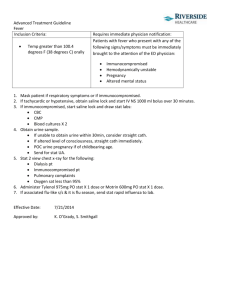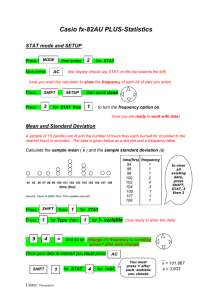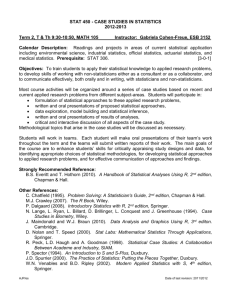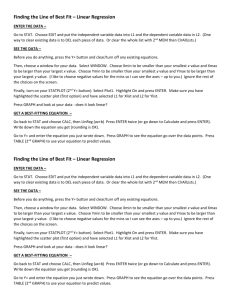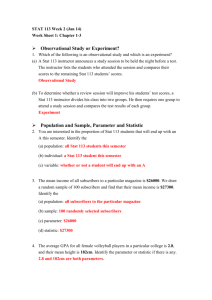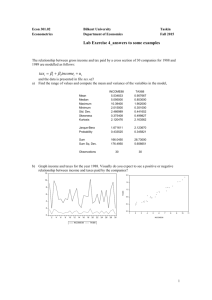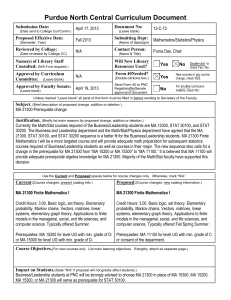The difference of A and B, denoted by AB
advertisement
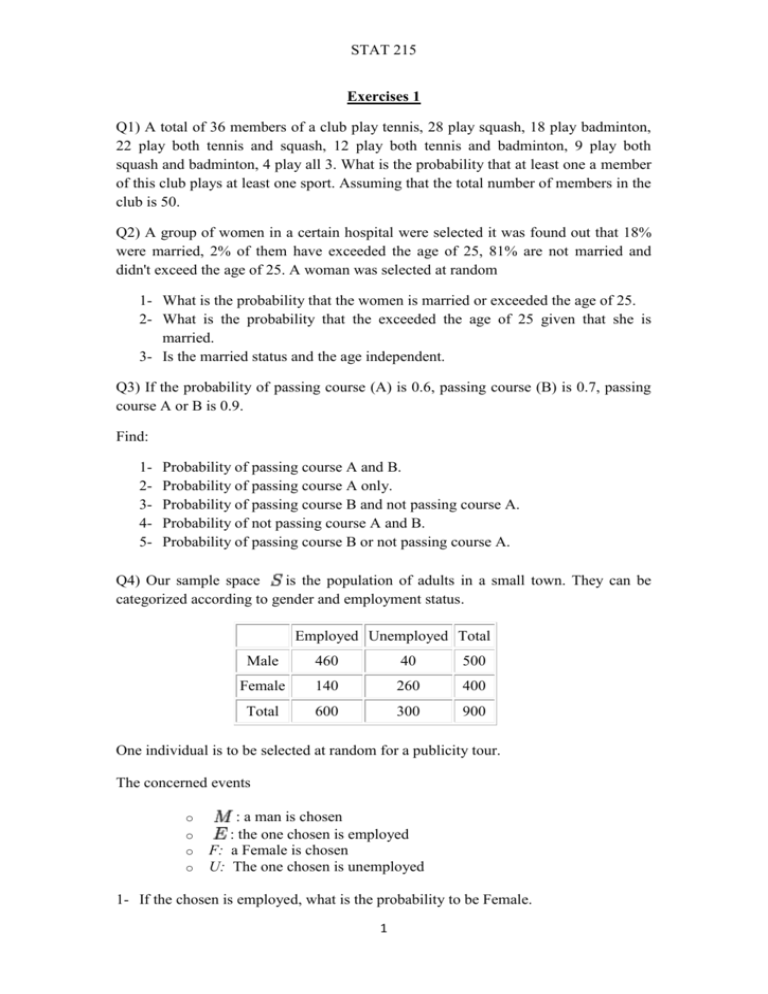
STAT 215
Exercises 1
Q1) A total of 36 members of a club play tennis, 28 play squash, 18 play badminton,
22 play both tennis and squash, 12 play both tennis and badminton, 9 play both
squash and badminton, 4 play all 3. What is the probability that at least one a member
of this club plays at least one sport. Assuming that the total number of members in the
club is 50.
Q2) A group of women in a certain hospital were selected it was found out that 18%
were married, 2% of them have exceeded the age of 25, 81% are not married and
didn't exceed the age of 25. A woman was selected at random
1- What is the probability that the women is married or exceeded the age of 25.
2- What is the probability that the exceeded the age of 25 given that she is
married.
3- Is the married status and the age independent.
Q3) If the probability of passing course (A) is 0.6, passing course (B) is 0.7, passing
course A or B is 0.9.
Find:
12345-
Probability of passing course A and B.
Probability of passing course A only.
Probability of passing course B and not passing course A.
Probability of not passing course A and B.
Probability of passing course B or not passing course A.
Q4) Our sample space
is the population of adults in a small town. They can be
categorized according to gender and employment status.
Employed Unemployed Total
Male
460
40
500
Female
140
260
400
Total
600
300
900
One individual is to be selected at random for a publicity tour.
The concerned events
o
o
o
o
: a man is chosen
: the one chosen is employed
F: a Female is chosen
U: The one chosen is unemployed
1- If the chosen is employed, what is the probability to be Female.
1
STAT 215
2- If the chosen is unemployed, what is the probability to be Female.
3- If the chosen is unemployed, what is the probability to be Male.
4- If the chosen is Male, what is the probability to be unemployed.
Q5) The probability that a regularly scheduled flight departs on time is P(D) = 0.83;
the probability that it arrives on time is P(A) = 0.82; and the probability that it
departs and arrives on time is P(D D A) = 0.78.
Find the probability that a plane
1- arrives on time given that it departed on time.
2- departed on time given that it has arrived on time.
3- arrived on time given that it has not departed on time.
Q6) Suppose we have a fuse box containing 20 fuses of which 5 are defective D and
12 are non-defective N. If 2 fuses are selected at random and removed from the box in
succession without replacing the first, what is the probability that both fuses are
defective.
Q7) Three cards are drawn in succession, without replacement, from an ordinary deck
of playing cards. Fined P(A1 A2 A3), where the events A1, A2 , and A3 are defined
as follows:
A1 = {the 1-st card is a red ace}
A2 = {the 2-nd card is a 10 or a jack}
A3 = {the 3-rd card is a number greater than 3 but less than 7}
Q8) Box I contains 3 red and 2 blue marbles while Box II contains 2 red and 8 blue
marbles. A fair coin is tossed. If the coin turns up heads, a marble is chosen from Box
I; if it turns up tails, a marble is chosen from Box II. Find the probability that a red
marble is chosen.
Q9) Suppose in Problem 1.15 that the one who tosses the coin does not reveal whether
it has turned up heads or tails (so that the box from which a marble was chosen is not
revealed) but does reveal that a red marble was chosen. What is the probability that
Box I was chosen (i.e., the coin turned up heads)?
Q10) Suppose that a fair die is thrown twice, then
2
STAT 215
1- The probability that sum of the numbers of the two dice is less than or equal to 4.
2- The probability that at least one of the die shows 4.
3- The probability that one die shows one and the sum of the two dice is four
Q11) Assume that P(A)=0.3, P(B)=0.4, 𝑃(𝐴 ∩ 𝐵 ∩ 𝐶)=0.3 and 𝑃(𝐴 ∩ 𝐵)=0.88, then
1- Are the events A and B independent?
2- Find 𝑃(𝐶|𝐴 ∩ 𝐵).
Q12) 200 adults are classified according to sex and their level of education in the
following table
Sex
Education
Male (M) Female (F)
Elementary (E)
28
50
Secondary (S)
38
45
College (C)
22
17
If a person is selected at random from this group, then
1- The probability that he is a male.
2- The probability that the person is male given that the person has a secondary
education.
3- The probability that the person does not have a college degree given that the person
is a female.
4- Are the events M and E independent?
3
STAT 215
Exercises 2
Q1)For each function below, determine if it can be probability density function. If so,
determine c.
5
a.𝑓1 (𝑥) = 𝑐(2𝑥 − 𝑥 3 ) ; 𝑓𝑜𝑟 0 < 𝑥 < 2
5
b. 𝑓2 (𝑥) = 𝑐(2𝑥 − 𝑥 2 ) ; 𝑓𝑜𝑟 0 < 𝑥 < 2
c. 𝑓3 (𝑥) = 𝑐(2𝑥 2 − 4𝑥) ; 𝑓𝑜𝑟 0 < 𝑥 < 3
d. 𝑓4 (𝑥) = 𝑐(2𝑥 2 − 4𝑥) ; 𝑓𝑜𝑟 0 < 𝑥 < 2
𝑐(1 − 𝑥 2 ) ; 𝑓𝑜𝑟 − 1 < 𝑥 < 1
Q2) The r.v. X has pdf 𝑓(𝑥) = {
0
; 𝑜𝑡ℎ𝑒𝑟𝑤𝑖𝑠𝑒
a. What is the value of c.
b. Find the following probabilities using the pdf of X:
i. P(X<0)
1
ii. 𝑃 (𝑋 ≥ 2)
1
1
iii. 𝑃 (− 2 < 𝑋 ≤ 2)
iv. P(X>1)
1
c. Graph the pdf f(x). Show 𝑃 (𝑋 ≥ − 2) on the graph.
d. What is the cdf of X.
e. Find the probabilities in (b) using the cdf.
𝑐𝑥 2 ; 𝑓𝑜𝑟1 < 𝑥 < 2
Q3) Suppose continuous r.v. X has density function 𝑓(𝑥) = {
0
; 𝑜𝑡ℎ𝑒𝑟𝑤𝑖𝑠𝑒
a. Find the value of the constant c. Graph the pdf.
3
b. Find 𝑃 (𝑋 ≥ 2). Show this probability on your graph.
c. Find the cumulative distribution function of X. Graph the cdf.
3
d. Find 𝑃 (𝑋 ≥ 2) using the cdf. Show this probability on the cdf graph.
Q4) Prove that 𝑃(𝑎 ≤ 𝑋 ≤ 𝑏) = 𝐹(𝑏) − 𝐹(𝑎) for continuous r.v. X. Explain why the
equality signs make no difference.
Q5) For a continuous r.v. X, prove that 𝑃(𝑋 ≥ 𝑐) = 1 − 𝐹(𝑐).
4
STAT 215
Q6) A system can function for a random amount of time X. If the density of X is
given (in units of months) by
𝑓(𝑥) = 𝐶𝑥𝑒 −𝑥/2 ; 𝑥 > 0
a. What is the probability that the system functions for at least 5 months.
b. What is the probability that the system functions from 3 to 6 months.
c. What is the probability that the system functions less than 1 month.
Q7) The cumulative distribution function of a continuous r.v. Y is given by
0 ; 𝑓𝑜𝑟 𝑦 ≤ 3
9
𝐹(𝑥) = {
1 − 2 ; 𝑓𝑜𝑟 𝑦 > 3
𝑦
Find
a. 𝑃(𝑋 ≤ 5).
b. 𝑃(𝑋 > 8).
c. the pdf of Y.
𝑥 ;0 < 𝑥 < 1
Q8) If the density function of the continuous r.v. X is 𝑓(𝑥) = {2 − 𝑥 ; 1 ≤ 𝑥 < 𝑐 .
0 ; 𝑜. 𝑤.
Find
a. The value of c.
b. The cumulative distribution function of X.
c. 𝑃(0.8 < 𝑋 < 0.6𝑐).
d. Graph f(x) and F(x). Show the probability in (c) on both graphs.
Q9) Let X1, X2 and X3 be independent r.v.'s with means 4, 9, 3 and variances 3, 7, 5
respectively. For Y=2X1-3 X2+4 X3 and Z=X1+2 X2- X3, find:
a. E(Y) and E(Z).
b. V(Y) and V(Z).
5
STAT 215
Q10) If X and Y are independent r.v.'s with E(X)=3, E(Y)=5, V(X)=2, and V(Y)=5,
find:
a. E(XY)
b. E(X2Y)
Q11) Let X and Y are independent r.v's with p.d.f 𝑓(𝑥) = 𝑒 −𝑥 ; 𝑥 > 0,
𝑓(𝑦) = 𝑒 −𝑦 ; 𝑦 > 0, find :
a. E(Y) and V(X).
b. E(Y) and V(Y).
c. E(XY).
d. E(X2 Y3).
1 −|𝑥|
𝑒
2
Q12) A r.v. has 𝑓(𝑥) =
; 𝑓𝑜𝑟 − ∞ < 𝑥 < ∞, find E(X) and V(X).
Q13) Let X1,X2,…,Xn be independent and identically distributed having mean 𝜇 and
2
1
variance 𝜎 2 . Let 𝑋 = 𝑛 ∑𝑛𝑖=1 𝑋𝑖 . Show that 𝐸 [∑𝑛𝑖=1(𝑋𝑖 − 𝑋) ] = (𝑛 − 1)𝜎 2 .
Q14) If we have
1
a. 𝑓(𝑥) = 𝑏−𝑎 ; 𝑎 ≤ 𝑥 ≤ 𝑏
b. 𝑓(𝑥) = 𝜆𝑒 −𝜆𝑥 ; 𝑥 > 0
c. 𝑓(𝑥) =
1
√2π𝜎
1
𝑒𝑥𝑝 [− 2𝜎2 (𝑥 − 𝜇)2 ] ; −∞ < 𝑥 < ∞
Find E(X) and V(X).
Q15) If 𝑋~𝐸𝑥𝑝(2) independent of 𝑌~𝐺𝑎𝑚𝑚𝑎(3,4), find:
a. E(XY).
b. E(X2 Y3).
6
STAT 215
c. V(X-Y)
d. V(3X+2Y)
where
pdf
E(X)
V(X)
𝐸𝑥𝑝(𝜆)
𝑓(𝑥) = 𝜆𝑒 −𝜆𝑥 ; 𝑥 > 0
1
𝜆
1
𝜆2
𝐺𝑎𝑚𝑚𝑎(𝛼, 𝛽)
𝛽 𝛼 𝛼−1 −𝛽𝑥
𝑓(𝑥) =
𝑥
𝑒
;𝑥
Γ𝛼
>0
𝛼
𝛽
𝛼
𝛽2
Q16) The probability distribution for company A is given by:
X
1
2
3
f(x)
0.3
0.4
0.3
and for company B is given by:
Y
0
1
2
3
4
f(y)
0.2
0.1
0.3
0.3
0.1
Show that the variance of the probability distribution for company B is greater than
that of company A.
7
STAT 215
Exercises 3
Q1) Let X be a random variable having an unknown distribution with mean =10 and
variance 2=16 . Find the following probability. " Use Chebyshev’s theorem"
(a) P(6 <X< 26)
(b) P(|X10| ≤ 12)
(c) P(|X10| > 12)
Q2) Use Chebyshev’s theorem to find what percent of the values will fall between
161 and 229 for a data set with mean of 195 and standard deviation of 17.
Q3) Use Chebyshev’s theorem to find what percent of the values will fall between
175 and 241 for a data set with a mean of 208 and standard deviation of 11.
Q4) Find the moment generating function of X If you know that f(x)=2e-2x, x>0
𝑒 2𝑡 −1
Q5) Suppose independent r.v.'s X and Y are such that 𝑀𝑋+𝑌 (𝑡) = 2𝑡−𝑡 2 .
If (𝑥) = 𝜆𝑒 −𝜆𝑥 ; 𝑥 > 0 , what is the distribution of Y.
Q6) A r.v. has 𝑓(𝑥) =
1 −|𝑥|
𝑒
2
; 𝑓𝑜𝑟 − ∞ < 𝑥 < ∞.
1
a. Show that its mgf is given by 𝑀𝑋 (𝑡) = 1−𝑡 2 for -1<t<1.
b. Using the mgf, find E(X) and V(X).
3
Q7) If X has 𝑓(𝑥) = 2 𝑥 2 , −1 < 𝑥 < 1
a. Find mgf of X.
b. Given the mgf in expanded form.
c. Use the expanded form to determine a general formula for 𝐸(𝑋 𝑛 ).
2
Q8) X and Y are independent and identically distributed with 𝑀(𝑡) = 𝑒 3𝑡+𝑡 . Find the
mgf of Z=2X-3Y+4.
1
2
Q9) Suppose X has 𝑀𝑋 (𝑡) = 𝑒 3𝑡+𝑡 . Find the mgf of 𝑍 = 4 (𝑋 − 3) and use it to find
the mean and variance of Z.
8
STAT 215
1
Q10) Suppose X is a r.v. for which the mgf is 𝑀𝑋 (𝑡) = (3𝑒 𝑡 + 𝑒 −𝑡 ), −∞ < 𝑡 < ∞ .
4
a. Find the mean and variance of X.
b. Find the expanded form of the mgf.
Q11) Let 𝑓(𝑥) = 1 ; 0 ≤ 𝑥 ≤ 1. Use the moment generating function technique to
find the moment generating function of Y=aX+b where a and b are constant.
Q12) Let 𝑓(𝑥) = 𝑒 −𝑥 ; 𝑥 > 0, find the mgf of Z=3-2X.
Q13) X, Y and Z are independent r.v.'s with 𝑋~𝑁𝑜𝑟𝑚𝑎𝑙(1,3), 𝑌~𝑁𝑜𝑟𝑚𝑎𝑙(5,2) and
2
the mgf of their sum being 𝑀𝑋+𝑌+𝑍 (𝑡) = 𝑒 13𝑡+3𝑡 . Determine the distribution of Z.
9
STAT 215
Exercises 4
Q1) In a certain city district the need for money to buy drugs is stated as the: reason
for 75% of all thefts. Find the probability that among the next 5 theft cases reported in
this district,
a. Exactly 2 resulted from the need for money to buy drugs.
b. At most 3 resulted from the need for money to buy.
Q2) In testing a certain kind of truck tire over a rugged terrain, it is found that 25% of
the trucks fail to complete the test run without a blowout. Of the next 15 trucks tested,
find the probability that
a. From 3 to 6 have blowouts.
b. Fewer than 4 have blowouts.
c. More than 5 have blowouts.
Q3) The probability that a patient recovers from a delicate heart operation is 0.9.
What is the probability that exactly 5 of the next 7 patients having this operation
survive?
Q4) It is known that 60% of mice inoculated with a serum are protected from a certain
disease. If 5 mice are inoculated, find the probability that
a. none contracts the disease.
b. fewer than 2 contract the disease.
c. more than 3 contract the disease.
Q5) In a study of brand recognition, 95% of consumers recognized Coke. The
company randomly selects 4 consumers for a taste test. Let X be the number of
consumers who recognize Coke.
a.
b.
c.
d.
Write out the PMF table for this.
Find the probability that among the 4 consumers, 2 or more will recognize Coke.
Find the expected number of consumers who will recognize Coke.
Find the variance for the number of consumers who will recognize Coke
Q6) Three people toss a fair coin and the odd man pays for coffee. If the coins all
turn up the same, they are tossed again. Find the probability that fewer than 4 tosses
are needed.
Q7) According to a study published by a group of University of Massachusetts
sociologists, about two thirds of the 20 million persons in this country who take
Valium are women. Assuming this figure to be a valid estimate, find the probability
that on a given day the fifth prescription written by a doctor for Valium is
a. The first prescribing Valium for a woman.
b. The third prescribing Valium for a woman.
Q8) The probability that a student passes the written test for a private pilot's license is
0.7. Find the probability that the student will pass the test
a. On the third try.
10
STAT 215
b. Before the fourth try. (u can add after, between two points).
Q9) From a lot of 10 missiles, 4 are selected at random and fired. If the lot contains 3
defective missiles that will not fire, what is the probability that
a. All 4 will fire?
b. At most 2 will not. fire?
Q10) A random committee of size 3 is selected from 4 doctors and 2 nurses. Write a
formula for the probability distribution of the random variable X representing
the number of doctors on the committee. Find P(2 ≤ X ≤ 3)
Q11) A manufacturing company uses an acceptance scheme on production items
before they are shipped. The plan is a two-stage one. Boxes of 25 are readied for
shipment and a sample of 3 is tested for defectives. If any defectives are found, the
entire box is sent back
for 100% screening. If no defectives are found, the box is shipped.
a. What is the probability that a box containing 3 defectives will be shipped?
b. What is the probability that a box containing only 1 defective will be sent back for
screening?
Q12) On average a certain intersection results in 3 traffic accidents per month.
For any given month at this intersection. What is the probability that:
a. Exactly 5 accidents will occur?
b. Less than 3 accidents will occur?
c. At least 2 accidents will occur?
For any given year at this intersection. What is the probability that:
a. Exactly 5 accidents will occur?
b. Less than 3 accidents will occur?
c. At least 2 accidents will occur?
Q13) A secretary makes 2 errors per page, on average. What is the probability that on
the next page he or she will make
a. 4 or more errors?
b. No errors?
Q14) A certain area of the eastern United States is, on average, hit by 6 hurricanes a
year. Find the probability that for a given year that area will be hit by
a. Fewer than 4 hurricanes;
b. Anywhere from 6 to 8 hurricanes.
c. Find the probability that for a given 3 months that area will be hit by fewer than 4
hurricanes.
Q15) When a die is tossed once, each element of the sample space occurs with
probability 1/6. Therefore we have a uniform distribution.
Find:
a.𝑃(1 ≤ 𝑋 < 4)
b.𝑃(3 < 𝑋 < 6)
c.𝑃(𝑋 < 3)
11
STAT 215
Q16) Find also the mean and variance.
X has is uniformly distributed on the set {1,2,3,...,N}, and
Y is uniformly distributed on the set {a,a+k,a+2k,...,b}, then find
a. P(X) and P(Y)
b. M(t) for X and for Y
c. E(X) and E(Y)
d. V(X) and Var(Y)
Q17) Suppose our class passed (C or better) the last exam with probability 0.75.
a. Find the probability that someone passes the exam.
b. Find the mean value of the random variable
c. Find the standard deviation value of the random variable
d. Find the moment generating function of the random variable
Q18) 20% from a population have a particular disease. In testing process for
infection by this disease.
a. Find the probability that someone infected by this disease.
b. Find the mean value of the random variable
c. Find the standard deviation value of the random variable
d. Find the moment generating function of the random variable
12
STAT 215
Exercises 5
Q1) Suppose X has a geometric distribution with p=0.8. Compute the probability of
the following events.
Q2) If the probability is 0.75 that an application for a driver's license will pass the
road test on any given try, what is the probability that an application will finally pass
the test on the fourth try
Q3) Suppose that 30% of the application for a certain industrial job have advanced
training in computer programming. Application are interviewed sequentially and are
selected at random from the pool. Find the probability that the first application having
advanced in programming is found on the fifth interview.
Q4) Let X be uniformly distributed on 0,1,…,99. Calculate
a. 𝑃(𝑋 ≥ 25).
b. 𝑃(2.6 < 𝑋 < 12.2).
c. 𝑃(8 < 𝑋 ≤ 10 𝑜𝑟 2 < 𝑋 ≤ 32).
d. 𝑃(25 ≤ 𝑋 ≤ 30).
Q5) If the probability is 0.40 that a child exposed to a certain contagious disease will
catch it, what is the probability that the tenth child exposed to the disease will be the
third to catch it.
Q6) In an assembly process, the finished items are inspected by a vision sensor, the
image data is processed , and a determination is made by computer as to whether or
not a unit is satisfactory. If it is assumed that 2% of the units will be rejected, then
what is the probability that the thirtieth unit observed will be second rejected unit?
Q7) If 2 balls are randomly drawn from a bowl containing 6 white and 5 black balls,
what is the probability that one of the drawn balls is white and the other black?
Q8) Of 10 girls in a class, 3 have blue eyes. If two of the girls are chosen at random,
what is the probability that
a. Both have blue eyes.
b. Neither have blue eyes.
13
STAT 215
c. At least one has blue eyes.
Q9) A company installs new central heating furnaces, and has found that for 15% of
all installations a return visit is needed to make some modifications. Six installations
were made in a particular week. Assume independence of outcomes for these
installations.
a. What is the probability that a return visit was needed in all of these cases?
b. What is the probability that a return visit was needed in none of these cases?
c. What is the probability that a return visit was needed in more than one of these
cases?
Q10) A fair die is rolled 4 times. Find
a. The probability of obtaining exactly one 6.
b.The probability of obtaining no 6.
c.The probability of obtaining at least one 6.
Q11) In a study of a drug -induced anaphylaxis among patients taking rocuronium
bromide as part of their anesthesia, Laake and Rottingen found that the occurrence of
anaphylaxis followed a Poisson model with
=12 incidents per year in Norway
.Find
a. The probability that in the next year, among patients receiving rocuronium, exactly
three will experience anaphylaxis?
b. The probability that less than two patients receiving rocuronium, in the next year
will experience anaphylaxis?
c. The probability that more than two patients receiving rocuronium, in the next two
years will experience anaphylaxis?
d. The expected value of patients receiving rocuronium, in the next 6 months who
will experience anaphylaxis.
e. The variance of patients receiving rocuronium, in the next year who will experience
anaphylaxis.
f. The standard deviation of patients receiving rocuronium, in the next year who will
experience anaphylaxis.
14
STAT 215
Q12) If the probability that an individual will suffer a bad reaction from injection of a
given serum is 0.001, determine the probability that out of 2000 individuals, (a)
exactly 3, (b) more than 2, individuals will suffer.
Q13) Suppose 2% of the items made by a factory are defective. Find the probability
that there are 3 defective items in a sample of 100 items.
15
STAT 215
Exercises 6
Q1) Find the moment generating function for the general normal distribution.
Q2) Show that the moment generating function of the random variable X which is Chi
square distribution with 𝑣 degree of freedom is 𝑀(𝑡) = (1 − 2𝑡)−𝑣/2 .
Q3) If X1 and X2 be independent r.v. that are chi-square dis. with v1 and v2 degrees
of freedom, respectively.
a. Show that the moment generating function of the random variable 𝑍 = 𝑋1 + 𝑋2 is
𝑀(𝑡) = (1 − 2𝑡)−(𝑣1+𝑣2)/2
b. What you can say about the distribution of the random variable Z.
Q4) Show that the mean and variance of gamma distribution are given by (a) 𝜇 = 𝛼𝛽
(b) 𝜎 2 = 𝛼𝛽 2 .
Q5) Let X be a normal distribution r.v. having mean 0 and variance 1. Show that 𝑋 2 is
chi-square distribution with d.f=1.
Q6) The grahp of chi-square distribution with 5 degrees of freedom is shown below.
Find the values of ᵡ12 , ᵡ22 for which
a. The shaded area on the right = 0.05,
b. The total shaded area = 0.05,
c. The shaded area on the left = 0.10,
d. The shaded area on the right = 0.01.
16
STAT 215
Q7) The grahp of t- distribution with 9 degrees of freedom is shown below. Find the
values of t1 , t 2 for which
a. The shaded area on the right = 0.05,
b. The total shaded area = 0.05,
c. The total unshaded area = 0.99,
d. The shaded area on the left = 0.01,
e. The area on the left of t1 = 0.90.
Q9) Let X be an exponential random variable with parameter 𝜆 = 𝑙𝑛(3). Compute the
following probability:𝑃(2 ≤ 𝑋 ≤ 4).
Q10) Suppose the random variable
parameter 𝜆 = 1.
has an exponential distribution with
a. Find 𝐹(𝑥).
b. Using 𝐹(𝑥), compute 𝑃(𝑋 > 2).
Q11) What is the probability that a random variable X is less than its expected value,
if X has an exponential distribution with parameter λ ?
Q12) Identify the distribution of the r.v. from the moment generating function
1
(a) 𝑀𝑥 (𝑡) = 1−2𝑡 , 𝑡 < 1/2
(b) 𝑀𝑥 (𝑡) = 𝑒 3𝑡+2𝑡
2
3
2
1
(c) 𝑋, 𝑌 independent, 𝑀𝑋+𝑌 (𝑡) = (2−𝑡) , 𝑡 < 2 , 𝑌~𝐸𝑥𝑝(1/2)
𝑒 2𝑡 −1
Q13) X, Y independent, 𝑀𝑋+𝑌 (𝑡) = 2𝑡−𝑡 2 , 𝑋~𝐸𝑥𝑝(1/2), what is the distribution of
Y
17
STAT 215
Exercises 7
Q1) The joint probability function of two discrete random variables X and Y is given
by f(x,y)= cxy for x=1, 2, 3 and y= 1, 2, 3 and equals zero otherwise. Find:
a. The constant c.
b. P(X=2,Y=3)
c. 𝑃(1 ≤ 𝑋 ≤ 2, 𝑌 ≤ 2).
d. 𝑃d. 𝑃(𝑋 ≥ 2).
e. 𝑃(𝑌 < 2).
f. 𝑃(𝑋 = 1).
g. 𝑃(𝑌 = 3).
Q2) For the random variables of Problem 1, find the marginal probability function of
X and Y. Determine whether X and Y are independent.
Q3) Let X and Y be continuous random variables having joint density function
2
2)
𝑓(𝑥, 𝑦) = {𝑐(𝑥 + 𝑦
0
0 ≤ 𝑥 ≤ 1,0 ≤ 𝑦 ≤ 1
𝑜𝑡ℎ𝑒𝑟𝑤𝑖𝑠𝑒
Determine
a. The constant c.
1
1
b. 𝑃 (𝑋 < 2 , 𝑌 > 2).
1
3
c. 𝑃 (4 < 𝑋 < 4).
1
d. 𝑃 (𝑌 < 2).
e. Whether X and Y are independent.
Q4) For the random variables of Problem 3, find the marginal probability function of
X and Y
Q5) For the distribution of Problem 1, find the conditional probability function of X
given Y, Y given X.
𝑥+𝑦
Q6) Let 𝑓(𝑥, 𝑦) = {
0
0 ≤ 𝑥 ≤ 1,0 ≤ 𝑦 ≤ 1
𝑜𝑡ℎ𝑒𝑟𝑤𝑖𝑠𝑒
18
STAT 215
Find the conditional probability function of X given Y, Y given X.
Q7) For the distribution of Problem 3, find the conditional probability function of X
given Y, Y given X.
Q8) Let 𝑓(𝑥, 𝑦) = {𝑒
−(𝑥+𝑦)
0
𝑥 ≥ 0, 𝑦 ≥ 0
𝑜𝑡ℎ𝑒𝑟𝑤𝑖𝑠𝑒
be the joint density function of X and Y. Find the conditional probability function of
X given Y, Y given X.
1/2 −1 ≤ 𝑥 ≤ 1
Q9) Let 𝑓(𝑥, 𝑦) = {
0
𝑜𝑡ℎ𝑒𝑟𝑤𝑖𝑠𝑒
Find the density of a. 3X-2 , b. X3+1.
2 3
Q10) Let 𝑓(𝑥, 𝑦, 𝑧) = {24 𝑥𝑦 𝑧
0
0 < 𝑥 < 1,0 < 𝑦 < 1,0 < 𝑧 < 1
𝑜𝑡ℎ𝑒𝑟𝑤𝑖𝑠𝑒
be the joint density function of three random variables. Find:
1
1
1
a. 𝑃 (𝑋 > 2 , 𝑌 < 2 , 𝑍 > 2).
b. 𝑃(𝑍 > 𝑋 + 𝑌).
Q11) Suppose that random variables X, Y and Z have joint density function
𝑓(𝑥, 𝑦, 𝑧) = {
1 − cos 𝜋𝑥 cos 𝜋𝑦 cos 𝜋𝑧
0
0 < 𝑥 < 1,0 < 𝑦 < 1,0 < 𝑧 < 1
𝑜𝑡ℎ𝑒𝑟𝑤𝑖𝑠𝑒
Show that although any two of these random variables are independent, i.e., their
marginal density function factors, all three are not independent.
Q12) Let X and Y be random variables having joint density function
𝑓(𝑥, 𝑦) = {
𝑐(2𝑥 + 𝑦) 0 < 𝑥 < 1,0 < 𝑦 < 2
0
𝑜𝑡ℎ𝑒𝑟𝑤𝑖𝑠𝑒
Find
19
STAT 215
a. The constant c.
1
3
b. 𝑃 (𝑋 > 2 , 𝑌 < 2).
c. The (marginal) density function of X.
d. The (marginal) density function of Y.
Q13) The joint probability function for the random variables X and Y is given in
following table, then find
Y
2
0
1
0
1/18
1/9
1/6
1
1/9
1/18
1/9
2
1/6
1/6
1/18
X
a. The marginal probability functions of X and Y.
b. 𝑃(1 ≤ 𝑋 < 3, 𝑌 ≥ 1).
c. Determine whether X and Y are independent.
Q14) Let X and Y be random variables having joint density function
𝑓(𝑥, 𝑦) = {
𝑥+𝑦
0
0 ≤ 𝑥 ≤ 1,0 ≤ 𝑦 ≤ 1
𝑜𝑡ℎ𝑒𝑟𝑤𝑖𝑠𝑒
Find: a. Var(X). b. Var(Y). c. 𝜎𝑋 . d. 𝜎𝑌 . e. 𝜎𝑋𝑌 . f. 𝜌.
Q15) Work Problem 14 if the joint density function is
𝑓(𝑥, 𝑦) = {𝑒
−(𝑥+𝑦)
0
𝑥 ≥ 0, 𝑦 ≥ 0
𝑜𝑡ℎ𝑒𝑟𝑤𝑖𝑠𝑒
Q16) Find a. The covariance. b. The correlation coefficient of two random variables X
and Y. If E(X)=2, E(Y)=3, E(XY)=10, E(X2)=9, E(Y2)=16.
Q17) The correlation coefficient of two random variables X and Y is -1/4 while their
variances are 3 and 5. Find the covariance.
20
STAT 215
𝑥𝑦
Q18) Let 𝑓(𝑥, 𝑦) = { 36
0
𝑥 = 1, 2, 3 𝑎𝑛𝑑 𝑦 = 1, 2, 3
𝑜𝑡ℎ𝑒𝑟𝑤𝑖𝑠𝑒
be the joint density function of X and Y. Find the conditional probability function of
X given Y, Y given X.
Q19) The joint probability function of two discrete random variables X and Y is given
by 𝑓(𝑥, 𝑦) = 𝑐(2𝑥 + 𝑦), where x and y can assume all integers such that 0 ≤ 𝑥 ≤ 2,
0 ≤ 𝑦 ≤ 3 , and 𝑓(𝑥, 𝑦) = 0 otherwise. Find:
a. The value of the constant c.
b. 𝑃(𝑋 = 2, 𝑌 = 1).
c. 𝑃(𝑋 ≥ 1, 𝑌 ≤ 2)
Q20) For the Problem 19, find a. E(X). b. E(Y). c. E(XY). d. E(X2). e. E(Y2). f.
Var(X). g. Var(Y). h. Cov(X,Y). i. 𝜌.
Q21) The joint density function of X and Y is given by
8𝑥𝑦
𝑓(𝑥, 𝑦) = {
0
0 ≤ 𝑥 ≤ 1, 0 ≤ 𝑦 ≤ 𝑥
𝑜𝑡ℎ𝑒𝑟𝑤𝑖𝑠𝑒
Find:
a. The marginal density of X.
b. The marginal density of Y.
c. The conditional density of X.
d. The conditional density of Y.
Q22) Find the conditional expectation of X given Y and Y given X in Problem 21.
Q23) Find the conditional variance of Y given X for Problem 21.
21
STAT 215
Exercises 8
Q1) If 𝑋~𝑈𝑛𝑖𝑓𝑜𝑟𝑚(0,1), find the pdf of Y=-2lnX. Name the distribution and its
parameter values.
Q2) If 𝑋~𝑈𝑛𝑖𝑓𝑜𝑟𝑚(𝑎, 𝑏), find the constants c and d such that Y=c+dX
𝑈𝑛𝑖𝑓𝑜𝑟𝑚(0,1).
Q3) If 𝑋~𝑁𝑜𝑟𝑚𝑎𝑙(𝜇, 𝜎 2 ), find the pdf of Y= eX.
Q4) If 𝑋~𝐸𝑥𝑝𝑜𝑛𝑒𝑛𝑡𝑖𝑎𝑙(1), find the pdf of Y=-lnX.
Q5) If 𝑋~𝑈𝑛𝑖𝑓𝑜𝑟𝑚(0,1), find the pdf of 𝑌 = √𝑋.
1
Q6) The pdf of X is given by 𝑓𝑋 (𝑥) = 2 𝑥 ; 0 < 𝑥 < 2.
a. Find the pdf of Y=X3.
1
1
b. Find 𝑃 (2 < 𝑋 < 1) and 𝑃 (8 < 𝑌 < 1). Are they the same or different? Why?
Q7) If 𝑋~𝜒42 , find P(X > 5).
Q8) If 𝑋~𝑈𝑛𝑖𝑓𝑜𝑟𝑚(0,1) independent of 𝑌~𝐸𝑥𝑝𝑜𝑛𝑒𝑛𝑡𝑖𝑎𝑙(1), find the distribution of
Z=X+Y:
a. Using the pdf formula derived in class.
b. By first finding the cdf and then differentiating.
Q9) If 𝑋~𝐺𝑎𝑚𝑚𝑎(2,3) independent of 𝑌~𝑈𝑛𝑖𝑓𝑜𝑟𝑚(0,2), and 𝑍~𝐺𝑎𝑚𝑚𝑎(5,3),
what is the distribution of X+Y+Z if X, Y and Z are independent?
22
STAT 215
Q10) If 𝑋~𝑁𝑜𝑟𝑚𝑎𝑙(2,3) independent of 𝑌~𝑁𝑜𝑟𝑚𝑎𝑙(5,1), and 𝑍~𝑁𝑜𝑟𝑚𝑎𝑙(20,21),
with X, Y and Z independent, find P(X+Y+Z < 25).
Q11) Let X and Y have joint pdf 𝑓(𝑥, 𝑦) = 1 ; −𝑦 < 𝑥 < 𝑦, 0 < 𝑦 < 1.
a. Find the conditional pdf of X|Y=y.
b. Find 𝑃(𝑋 < 0|𝑌 = 𝑦).
1
1
c. Find 𝑃(𝑋 > 4 |𝑌 = 3).
1
1
4
2
d. Find 𝑃(0 < 𝑋 < |𝑌 = ).
2
Q12) Let X and Y have joint pdf 𝑓(𝑥, 𝑦) = (𝑥 + 4𝑦) ; 0 < 𝑥 < 1, 0 < 𝑦 < 1.
5
a. Find the conditional pdf of Y|X=x.
1
1
b. Find 𝑃(𝑌 < 3 |𝑋 = 2).
Q13) If 𝑋~𝑈𝑛𝑖𝑓𝑜𝑟𝑚(0,1) independent of 𝑌~𝐸𝑥𝑝𝑜𝑛𝑒𝑛𝑡𝑖𝑎𝑙(1), find
a. The joint density function of Z=X+Y and U=X/Y.
b. The density function of Z.
c. The density function of U.
1
Q14) Let (X,Y) have joint pdf 𝑓(𝑥, 𝑦) = 𝑥 2 𝑦 2 ; 𝑥 ≥ 1, 𝑦 ≥ 1.
a. Find the joint density of U=XY and V=X/Y.
b. What are the marginal density of U and V?
Q15) Let X1 and X2 be independent 𝐸𝑥𝑝(𝜆) r.v. Find the joint density of
𝑌1 = 𝑋1 + 𝑋2 and 𝑌2 = 𝑒 𝑋1 .
Q16) Let 𝑋1 ~𝐸𝑥𝑝(𝜆1 ) independent of 𝑋2 ~𝐸𝑥𝑝(𝜆2 ) r.v.. Find:
23
STAT 215
a. The cumulative distribution function of 𝑍 =
𝑋1
𝑋2
.
b. 𝑃(𝑋1 < 𝑋2 ).
Q17) The joint pdf of (X,Y) is given by 𝑓(𝑥, 𝑦) =
𝑒 −𝑦
𝑦
; 0 < 𝑥 < 𝑦, 0 < 𝑦 < ∞. Find
E(X), E(Y), V(X), V(Y) and Cov(X,Y).
Q18) Let X and Y be distributed as independent Uniform(0,1) r.v.
a. Find the joint density function of Z1= X+Y and Z1= Y.
b. Find the marginal pdf of Z1 from the joint density.
Q19) Let X and Y be distributed as independent Exp(1) r.v., find:
a. The joint density function of 𝑍 = 𝑋 + 𝑌 and 𝑈 =
𝑋
𝑋+𝑌
.
b. Find the marginal pdf of U.
Q20) Let (X,Y) have joint density given by 𝑓(𝑥, 𝑦) = 24𝑥𝑦 ; 0 < 𝑥 < 1, 0 < 𝑦 < 1,
𝑥 + 𝑦 < 1, find the pdf of 𝑍 = 𝑋𝑌 2 .
Q21) Let X and Y have independent 𝐺𝑎𝑚𝑚𝑎(𝛼, 𝜆) distributions.
a. Find the joint pdf of 𝑈 =
𝑋
𝑋+𝑌
and 𝑉 = 𝑋 + 𝑌.
b. Show that the marginal density of U is a Beta distribution.
Q22) Let (X,Y) have joint density given by 𝑓(𝑥, 𝑦) = 24𝑥𝑦 ; 0 < 𝑥 < 1, 0 < 𝑦 < 1,
𝑥 + 𝑦 < 1, find:
a. The marginal pdf's.
b. The following expectations:
i. E(X) and E(X2).
ii. E(Y) and E(Y2).
24
STAT 215
iii. E(XY) and E(X2 Y3).
iv. V(X), V(Y), Cov(X,Y). Do X and Y have a positive or negative relationship?
1
Q23) Let joint pdf of (X,Y) given by 𝑓(𝑥, 𝑦) = 𝑦 𝑒 −𝑦 𝑒 −𝑥/𝑦 ; 𝑥 > 0, 𝑦 > 0, find:
a. E(X) and E(X2).
b. E(Y) and E(Y2).
c. EShow that Cov(X,Y)=1.
d. 𝜌(𝑋, 𝑌).
Q24) If X, Y, Z ~ independent Exp(1), derive the joint distribution of U=X+Y,
V=X+Z, and Z=Y+Z.
If 𝑋𝑖 𝑖𝑛𝑑𝑝𝑡. 𝐸𝑥𝑝(), 𝑡ℎ𝑒𝑛 𝑡ℎ𝑒 𝑠𝑢𝑚 ∑𝑖=𝑛
𝑖=1 𝑋𝑖 ~ 𝐺𝑎𝑚𝑚𝑎 (𝑛, )
𝑖=𝑛
If 𝑋𝑖 𝑖𝑛𝑑𝑝𝑡. 𝐺𝑎𝑚𝑚𝑎(𝛼𝑖 , 𝛽), 𝑡ℎ𝑒𝑛 𝑡ℎ𝑒 𝑠𝑢𝑚 ∑𝑖=𝑛
𝑖=1 𝑋𝑖 ~ 𝐺𝑎𝑚𝑚𝑎 (∑𝑖=1 𝛼𝑖 , 𝛽)
𝑖=𝑛
𝑖=𝑛 2
If 𝑋𝑖 𝑖𝑛𝑑𝑝𝑡. 𝑁𝑜𝑟𝑚𝑎𝑙(𝜇𝑖 , 𝜎𝑖2 ), 𝑡ℎ𝑒𝑛 𝑡ℎ𝑒 𝑠𝑢𝑚 ∑𝑖=𝑛
𝑖=1 𝑋𝑖 ~ 𝑁𝑜𝑟𝑚𝑎𝑙 (∑𝑖=1 𝜇𝑖 , ∑𝑖=1 𝜎𝑖 )
2
If 𝑋𝑖 𝑖𝑛𝑑𝑝𝑡. 𝑁𝑜𝑟𝑚𝑎𝑙(𝜇0 , 𝜎02 ), 𝑡ℎ𝑒𝑛 𝑡ℎ𝑒 𝑠𝑢𝑚 ∑𝑖=𝑛
𝑖=1 𝑋𝑖 ~ 𝑁𝑜𝑟𝑚𝑎𝑙 (𝑛𝜇0 , 𝑛𝜎0 )
If 𝑍 𝑁𝑜𝑟𝑚𝑎𝑙(0,1), 𝑡ℎ𝑒𝑛 𝑡ℎ𝑒 𝑍 2 ~ 𝟐𝟏
If 𝑋 ~ 𝟐𝒏 , 𝑖𝑛𝑑, 𝑜𝑓 𝑌 ~ 𝟐𝒎, 𝑡ℎ𝑒𝑛 𝑡ℎ𝑒 𝑋 + 𝑌~ 𝟐𝒏+𝒎
If 𝑍1 𝑁𝑜𝑟𝑚𝑎𝑙(0,1), 𝑖𝑛𝑑. 𝑜𝑓 𝑍2 𝑁𝑜𝑟𝑚𝑎𝑙(0,1) 𝑡ℎ𝑒𝑛 𝑡ℎ𝑒 𝑍1 + 𝑍2 ~ 𝟐𝟐
Yusra Tashkandi
Dr. Saba Elwan
25

